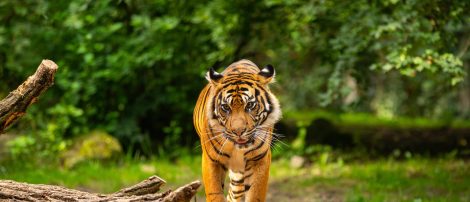Ranthambore National Park
The Ranthambore National Park – also known as the ‘Ranthambore National Park’ and the ‘Ranthambore Tiger Reserve’- is rated among one of the finest tiger reserves in India. Located amidst the picturesque surroundings of the Aravalis and the Vindhya ranges in eastern Rajasthan, the Ranthambore National Park is known for its rich and varied flora and fauna. The park spreads over an area of approximately 400 sq km in a highly undulating and rugged terrain with numerous rocky ridges, hills and open valleys with lakes and pools. Two rivers, the Chambal and the Banas flowing in the South and the North of the park respectively, and six artificial lakes namely the Gilai Sagar, Mansarovar, Malik Talao, Raj Bagh and Padam Talao within the park, add to the beauty of the Ranthambore National Park. The lush green vegetation along with plenty of water availability makes it an ideal place for survival and growth of varied wildlife. The park offers perfect conditions for tigers and their prey. The greatest attractions of the Ranthambore National Park are the world-famous Royal Bengal Tigers. Once the favorite hunting ground of the Maharaja of Jaipur, the Ranthambore National Park was declared a game sanctuary in 1955, a tiger reserve in 1973 under India’s famous Project Tiger Plan and finally attained the status of a national park in 1980. The Ranthambore National Park supports a wide variety of wildlife ranging from mammals to birds and reptiles. But, the most important wild animal of the Ranthambore National Park is the Tiger. The park promises to offer the best of opportunities to track a tiger in its own natural habitat and so it is a favorite with wildlife photographers. For a relatively small area, the park has a rich diversity of fauna and flora that include about 30 mammal species, 272 bird species, 12 reptile species and 350 plant species including 50 aquatic plants. Apart from the Royal Bengal Tigers, the other major wildlife at the Ranthambore National Park include Panthers, Chital, Sambar, Blackbuck, Chinkara, Leopard, Sloth Bear, Hyena, Jackal, Wild Boars, Mongoose, Nilgai, Gazelle, Bears, Indian Hare, Monitor Lizards and a large number of exotic and colorful birds.
The Ranthambore National Park is also a heritage site, as it houses some important ruins, dotted all around the park. The 10th century Ranthambore Fort, from which the park derives its name, is probably the oldest existing fort in Rajasthan and a major tourist attraction in the park. In addition there are many lake palaces and ‘chhatris’, overlooking the park. Located at the foot of the fort is the lovely Jogi Mahal, another attraction inside the Ranthambore National Park. The Jogi Mahal also boasts the second-largest Banyan tree in India.
Another major attraction at the Ranthambore National Park is the enjoyable wildlife safaris. The visitors of the park can enjoy a jeep, elephant or a boat safari to explore the natural beauty and wildlife of the Ranthambore National Park.
Best Time to Visit
The best time to visit the Ranthambore National Park is October-March, when the minimum temperature is less than 10 degree Celsius, providing good chances for animal and bird sightings. April- June also offers excellent opportunities for animal sightings.
The Ranthambore National park remains closed from 1st July to 30th September due to Monsoon seasons in India.
How to Reach
By Air: The nearest airport from the Ranthambore National Park is Jaipur (145 km).
By Rail: Sawai Madhopur railway station is about 11 km from the Ranthambore National Park, which lies on the Delhi to Bombay trunk route.
By Road: The Park is at a distance of about 11 km from Sawai Madhopur- the nearest town from the Ranthambore National Park. The town is well connected by road to all the major cities within the state of Rajasthan.
Get Free Quote
Just fill the form and we will get back to you with a
custom made tour plan


